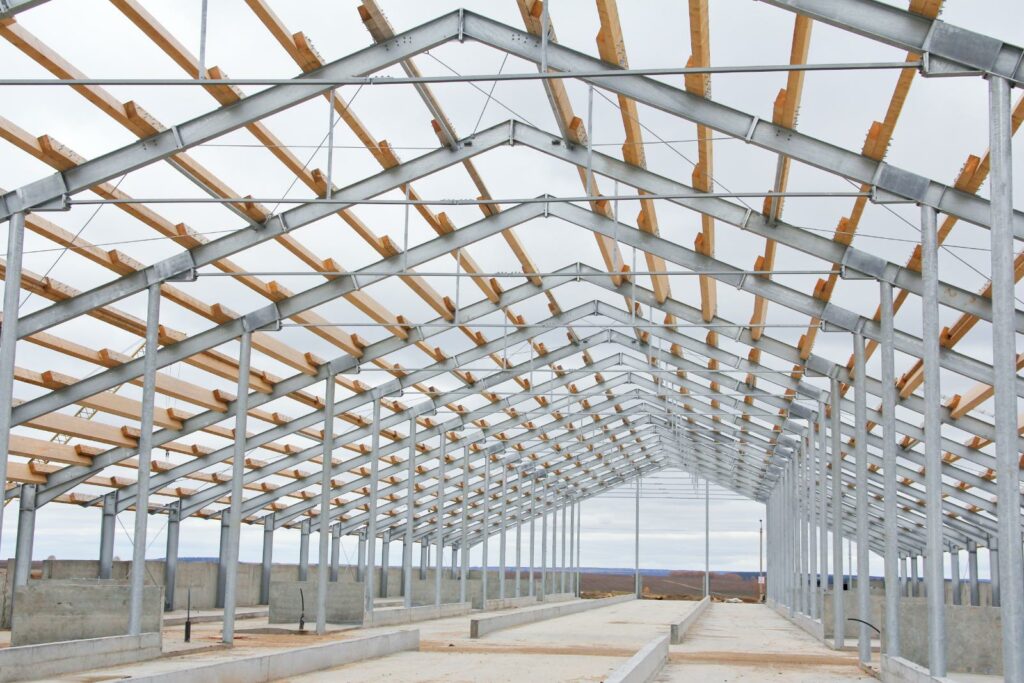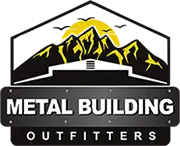
Contents
When considering the construction of metal structures that can endure diverse weather conditions, look to the Beijing National Stadium, also known as the “Bird’s Nest.” This iconic structure’s resilience to extreme temperatures and environmental challenges showcases the importance of meticulous planning and material selection. Understanding the nuances of weather-resistant steel and protective coatings is just the beginning. Would you like to uncover the secrets behind successful, long-lasting metal structures that defy the elements and stand the test of time?
Key Takeaways
- Use weather-resistant steel for exceptional durability in all climates.
- Prioritize corrosion resistance with protective coatings and metal treatments.
- Select materials based on environmental stressors and specific weather conditions.
- Implement regular maintenance and inspections to ensure longevity.
- Explore customization options like powder coating and galvanization for enhanced weather resistance.
Weather-Resistant Steel: Key Characteristics
When considering long-lasting metal structures for any weather, understanding the key characteristics of weather-resistant steel is essential. Weather-resistant steel, also known as corten steel, exhibits exceptional application versatility and environmental performance. Its unique composition allows it to withstand harsh environmental conditions, making it a popular choice for various construction projects.
One of the standout features of weather-resistant steel is its versatility in application. This type of steel can be used in a wide range of structural applications, from buildings and bridges to outdoor sculptures and facades. Its ability to blend seamlessly with different architectural styles while providing long-term durability makes it a favored material for designers and architects.
In terms of environmental performance, weather-resistant steel excels in withstanding corrosion, rust, and degradation caused by exposure to elements such as rain, snow, humidity, and sunlight. This durability is achieved through the formation of a protective patina on the steel’s surface, which not only enhances its resistance to corrosion but also eliminates the need for additional protective coatings.
Benefits of Weather-Resistant Steel
You benefit from weather-resistant steel due to its exceptional durability in all climates.
This type of steel offers significant advantages in corrosion resistance, ensuring your structures remain intact over time.
Its longevity in harsh conditions provides a cost-effective solution for long-lasting metal structures.
Durability in All Climates
Employing weather-resistant steel provides durable metal structures that can withstand the harshest climates with minimal maintenance requirements. This type of steel is designed to endure extreme temperatures, from scorching heat to freezing cold, without compromising its structural integrity.
Its exceptional climate resilience ensures that your metal structures remain stable and reliable regardless of the weather conditions they face. With weather-resistant steel, you can feel confident that your buildings, bridges, or other metal constructions will stand the test of time, providing a sense of security and longevity.
Investing in this material not only secures the longevity of your structures but also offers peace of mind, knowing that they’re built to last in any climate.
Corrosion Resistance Advantages
With weather-resistant steel, the corrosion resistance advantages are unparalleled, ensuring long-lasting metal structures that can withstand any weather conditions. Corrosion prevention techniques and metal coatings play a vital role in enhancing the longevity of metal structures. Surface treatment methods such as rust inhibitors are applied to weather-resistant steel to protect against oxidation and corrosion, greatly extending the lifespan of the material. These advanced techniques create a protective barrier that shields the steel from environmental elements, preventing rust and decay. By utilizing these corrosion-resistant advantages, you can have confidence in the durability and reliability of your metal structures, even in the most challenging weather conditions.
Longevity in Harsh Conditions
In harsh conditions, weather-resistant steel demonstrates exceptional durability and resilience, making it a top choice for long-lasting metal structures. When faced with extreme conditions such as heavy rainfall, snow, or intense heat, weather-resistant steel maintains its structural integrity over time.
This type of steel is specifically designed to withstand the challenges posed by harsh environmental factors, ensuring that your metal structure remains strong and reliable. By utilizing weather-resistant steel, you can increase the longevity of your construction projects, reducing maintenance costs and the need for frequent repairs.
The superior resistance of weather-resistant steel to corrosion and rust contributes greatly to its ability to thrive in harsh conditions, providing you with peace of mind regarding the durability of your metal structures.
Design Considerations for Durability
When designing for durability, you must carefully consider both the material selection and the application of protective coatings.
The choice of materials will impact the structure’s resistance to corrosion and other environmental factors. Proper coatings can further enhance the longevity of metal structures exposed to varying weather conditions.
Material Selection
Material selection plays an important role in determining the durability of metal structures in various weather conditions. When contemplating material sustainability, it is essential to select metals that can withstand the intended environmental stressors over time. The impact of the weather is a significant factor to take into account; for instance, materials exposed to coastal areas require corrosion-resistant alloys. Below is a table outlining specific metals and their characteristics for different weather conditions:
| Metal Type | Weather Condition | Key Characteristic |
|---|---|---|
| Stainless Steel | Coastal Areas | Corrosion Resistance |
| Aluminum | High Humidity Areas | Lightweight |
| Galvanized Steel | Rainy Climates | Rust Protection |
| Copper | Dry Heat Regions | Heat Conductivity |
| Titanium | Extreme Temperatures | High Strength |
Protective Coatings
To enhance the durability of metal structures in various weather conditions, consider incorporating protective coatings with specific design considerations for long-lasting performance. Proper surface preparation is vital before applying protective coatings to guarantee adhesion and effectiveness.
Techniques such as abrasive blasting or chemical cleaning help remove contaminants and create a suitable surface for coating adhesion. When choosing application techniques, factors like environmental conditions and coating type should be considered to achieve the best results. Consistent thickness application is essential for uniform protection across the metal surface.
Regular inspections and maintenance can help identify areas that may need recoating or touch-ups to prolong the lifespan of the protective coating system.
Maintenance Tips for Longevity
Regularly inspecting and promptly addressing any signs of corrosion or damage is essential for maintaining the longevity of metal structures in varying weather conditions. By implementing preventive measures and establishing thorough inspection routines, you can guarantee the durability of your metal structures. Here are some maintenance tips to help you achieve this:
| Maintenance Tip | Description | Frequency |
|---|---|---|
| Visual Inspections | Conduct visual checks for rust, scratches, or dents. | Monthly |
| Cleaning and Washing | Remove dirt, debris, and contaminants using appropriate cleaning solutions. | Bi-Weekly |
| Protective Coating Checks | Regularly assess the condition of protective coatings and reapply when necessary. | Annually |
Visual inspections should be carried out monthly to detect any early signs of corrosion. Cleaning and washing your metal structures bi-weekly will prevent the buildup of damaging substances. It is essential to check the protective coatings annually to ensure they are intact and provide adequate protection against the elements. By following these maintenance tips diligently, you can prolong the life of your metal structures and maintain their structural integrity throughout changing weather conditions.
Customization Options for Weather Resistance
Explore incorporating advanced weather-resistant coatings to enhance the durability of your metal structures in harsh environmental conditions. By customizing your metal structures with weather-resistant solutions, you not only increase their longevity but also improve their aesthetic appeal.
Here are some customization options worth exploring:
Powder Coating: This method involves applying a dry powder to the metal surface, which is then cured under heat to form a protective layer. Powder coating not only provides excellent weather resistance but also allows for a wide range of color options to enhance the visual appeal of your structures.
Galvanization: Galvanizing metal structures involves coating them with a protective layer of zinc to prevent corrosion. This process is highly effective in harsh weather conditions, making it a popular choice for outdoor structures that need to withstand the elements.
Ceramic Coating: Ceramic coatings offer exceptional durability and weather resistance. These coatings create a hard shell over the metal surface, protecting it from corrosion, UV rays, and extreme temperatures. Additionally, ceramic coatings can be customized to achieve different finishes, adding to the aesthetic appeal of your metal structures.
Cost-Effective Weather-Resistant Solutions
For cost-effective solutions that enhance weather resistance in metal structures, consider implementing advanced coatings and treatments. When looking to optimize the durability of metal structures without breaking the bank, cost-effective solutions are key. By integrating innovative designs and materials, you can achieve long-lasting weather-resistant properties while staying within budget constraints.
One approach to cost-effective weather-resistant solutions is the utilization of specially formulated coatings. These coatings act as a protective barrier against environmental elements, preventing corrosion and extending the lifespan of the metal structure. By choosing the right coating based on the specific weather conditions the structure will face, you can enhance its resistance to factors like moisture, UV radiation, and chemical exposure.
In addition to coatings, treatments such as galvanization offer a cost-effective way to boost weather resistance. Galvanization involves applying a protective zinc coating to the metal, providing corrosion protection and increasing longevity. This method is particularly effective in harsh weather conditions, making it a reliable and economical choice for enhancing the durability of metal structures.
Case Studies: Successful Metal Structures
To illustrate the effectiveness of weather-resistant solutions in metal structures, we present insightful case studies showcasing successful implementations in various environments. These case studies highlight the importance of innovative designs and structural integrity in creating long-lasting metal structures that withstand any weather conditions.
Innovative Designs:
The first case study features a cutting-edge architectural firm that utilized advanced computer modeling to create a metal structure with intricate geometries. By incorporating innovative designs that maximized aerodynamics and minimized exposure to harsh elements, the structure has remained durable and visually striking over the years.Structural Integrity:
The second case study focuses on a bridge construction project that prioritized structural integrity through the use of high-quality steel and meticulous welding techniques. Despite facing extreme weather fluctuations, including high winds and heavy snow loads, the bridge has maintained its structural integrity without any signs of corrosion or weakening.Sustainable Materials:
The final case study showcases a sustainable approach to metal structure construction by using eco-friendly materials that aren’t only weather-resistant but also contribute to environmental conservation. This project emphasizes the importance of balancing durability with sustainability to create metal structures that can withstand any weather condition for years to come.
Summary
When it comes to creating long-lasting metal structures for any weather, the key lies in selecting weather-resistant materials like corten steel and incorporating protective coatings.
By focusing on innovative designs, quality materials, and proper maintenance, you can guarantee that your metal structures stand strong against the elements like a sturdy fortress in a storm.
Remember, with the right approach, your metal structures can weather any storm with resilience and grace.
Recent Posts
Top Eco-Friendly Tips for Metal Building Construction
Have you ever wondered how metal building construction can align with eco-friendly practices? By exploring
What Techniques Enhance Energy Efficiency in Metal Buildings?
To improve energy efficiency in metal buildings, you need to encompass a variety of methods.
Top Tips for Energy Efficient Custom Metal Structures
When aiming to maximize the energy efficiency of your custom metal structures, it’s crucial to


